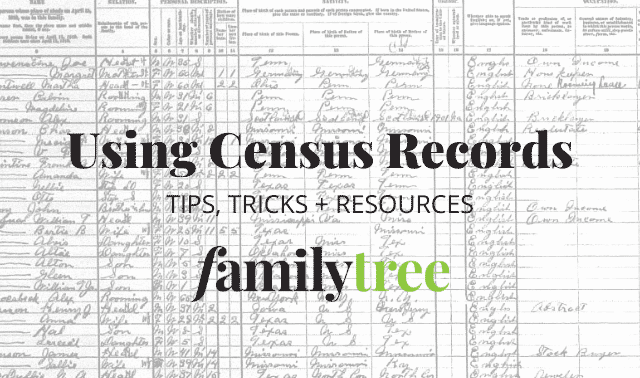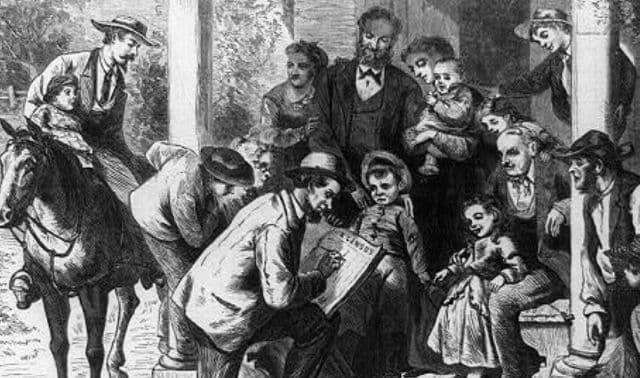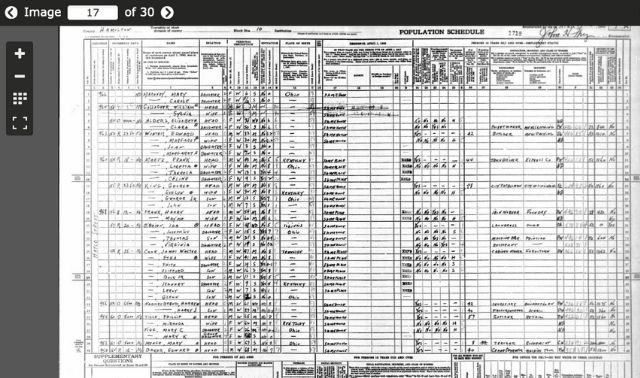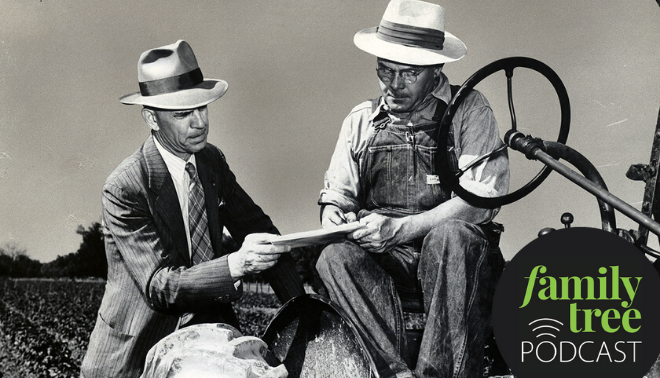Sign up for the Family Tree Newsletter! Plus, you’ll receive our 10 Essential Genealogy Research Forms PDF as a special thank you.
Get Your Free Genealogy Forms
"*" indicates required fields
Table of Contents
The release of a US census is akin to the coming of a great genealogical comet: A new one comes only once every 10 years. Family historians anxiously await its arrival. When it finally appears, it can be exhilarating.
As of 1 April 2022, one such comet has come: the 1950 census. Blazing across computer screens everywhere is a brilliant stream of genealogical data. And in its wake, you’ll find names, ages, places, family relationships, occupations and more for over 150 million people.
As the census shoots into your genealogical orbit, you’ll want to be ready. You won’t need a telescope or a star chart—just internet access and a little knowledge of your US relatives in 1950.
When Will the 1950 Census Be Released?
The 1950 census was released on April 1, 2022. The census is available for free through the National Archives and Records Administration (NARA) through a dedicated website.
When Will the Census Be Released on Ancestry.com, FamilySearch and MyHeritage?
After the National Archives released the records, Ancestry.com created an initial index using artificial intelligence and handwriting recognition technology. Then, volunteers reviewed and corrected the index.
Thanks to advancements in technology and the dedicated effort of volunteer genealogists, census records were keyword-searchable within a matter of days after the release.
How to Prepare for the 1950 Census Release
A little prep can go a long way in preparing for the census. Here are a few tasks you can do to make sure you’re ready to research:
- Study your ancestors during 1940
- Create a timeline of key events in your ancestor’s life before and after 1950
- Determine your ancestor’s address in approximately 1950 and find the correct enumeration district
- Prep extraction sheets
- Brush up on how to browse records
1950 Census Form Image

What Questions Were on the 1950 Census?
Let’s take a look at what was asked in the census. As you’ll see, some questions were only asked of randomly selected respondents, and a person’s response to one question may determine if they were asked another.
Household Information
The population schedule requested detailed information about every person who lived in a household. The first several questions were answered only by the head of household, typically the father or husband, unless the family recognized someone different in that role:
- Column 1: Street name
- Column 2: House number (and apartment number, if applicable)
- Column 3: Count of dwellings in the order visited
- Column 4: Whether the house was on a farm or ranch
- Column 5: Whether property was on a piece of land that was three acres or larger if not a farm or ranch
- Column 6: Agricultural schedule number (cross-reference for those who answered yes to questions 4 or 5)
The next several columns were answered by everyone who normally slept in that household (with a few exceptions). Members were to be listed in a specific order, as described in a column header, with the following information:
- Column 7: Name, with last name first
- Column 8: Relationship to head of household (e.g., wife, son, patient, tenant)
- Column 9: Race: W for white, Neg for Black/Negro, Ind for American Indian, Jap for Japanese, Chi for Chinese, Fil for Filipino; other responses were to be spelled out
- Column 10: Sex, male (M) or female (F)
- Column 11: Age at last birthday as of censustaker’s visit; birth month for children less than 1 year old
- Column 12: Marital status; Mar for married, Wd for widowed, D for divorced, Sep for separated, and Nev for never married
- Column 13: Birthplace (state/territory, foreign country, etc.)
- Column 14: Naturalization status if foreign-born; Yes if naturalization finalized or No if it hadn’t; AP for someone born abroad to American parents
Employment Questions
Those age 14 and older responded to additional queries about their employment, with the lineup of questions depending on their response to question 15:
- Column 15: Work activity for the week prior; Wk for paid or unpaid work, H for keeping their own house, U for unable to work, Inmate for residents of institutions, Ot for other (including students and the temporarily disabled)
- Column 16: If any other work if answered question 15 with H or Ot; a Yes meant they worked at least one hour of qualifying work the week before
- Column 17: If looking for work if answered question 16 with No
- Column 18: If has a job or own business if answered question 17 with No; a Yes would imply the person had a job but didn’t work “last week” because of illness, vacation, labor disputes, etc.
- Column 19: Number of hours worked the previous week
- Column 20a: Job title or description for current position
- Column 20b: Kind of business or industry in which currently or recently employed
- Column 20c: Class of worker; P for private employers, G for government workers, O for self-employed, NP for working without pay for a household farm or business
Supplementary Questions
Every fifth person on the population schedule answered additional “sample” questions at the bottom of the page about their past year’s residence, parents’ origin, and education. Respondents were selected by line number, though which numbers indicating sample responses varied by form. The questions themselves were the same:
- Column 21: If living in the same house one year ago
- Column 22: If No to question 21, if living on a farm one year ago
- Column 23: If No to question 21, if living in the same county one year ago
- Column 24: If No to question 23, what county (a) or state/foreign country (b) living one year ago
- Column 25: Birthplace(s) of father and mother
- Column 26: Highest grade/level of school
- Column 27: Whether finished highest grade level
- Column 28: If attended school since February 1
Sample respondents over the age of 14 were also asked about weeks worked and income:
- Column 29: How many weeks spent looking for work, if any (indicated by question 17)
- Column 30: How many weeks worked outside of home in last year
- Column 31: Income in last year from (a) wages or salary, i.e., income from an employer; (b) own business or practice; (c) non-earning sources such as investments and pensions
- Column 32: Income in last year for whole household if respondent is the head of household
- Column 33: Military service if respondent is male, with separate columns for World War II (a), World War I (b) and “any other time” (c)
On each page, one of those sample respondents was asked additional questions if age 14 or older. Question 34 assessed whether those who worked outside the home in the past year (question 30) also responded to questions 20a through 20c about type of work. If they didn’t, they were asked to fill in that information about their most recent job in 35a through 35c. Otherwise, respondents skipped to the remaining questions:
- Column 36: If married more than once, if married at all
- Column 37: Years since most recent marital status change
- Column 38: Number of children borne, not counting stillbirths, if respondent is female and has been married
Lost Responses
A detailed housing survey appeared on the reverse side of every population schedule. Unfortunately, it wasn’t microfilmed, and eventually the original census forms were destroyed. These and the agricultural schedules exist now only as compiled statistics. Infant cards and individual census report forms (also part of the wider 1950 census) are no longer available, either.
The History and Creation of the 1950 Census
Much like the tail of a comet carries clues to the cosmos’ origins, the 1950 census reveals a unique time period (just not quite as long ago).
The world of 1950 looked dramatically different than it did during the prior census. In 1940, effects of the Great Depression lingered. Then World War II pushed millions of men and women into military service, new jobs, or even into the workforce for the first time.
After the conflict ended, veterans returned to civilian jobs in a robust economy. Corporations and white-collar jobs expanded. New technologies and materials led to new products and lifestyles for a growing middle class. Demand for new houses and automobiles skyrocketed. Suburbs bloomed, and families grew in the “Baby Boom.”
Prosperity didn’t knock on every door, though. Blue-collar occupations declined. Prejudicial policies limited work and housing options for nonwhite workers and their families. After the war, many women who wanted to remain in the workforce lost their jobs or were forced into more menial work. Big agricultural companies supplanted many of the family farms that managed to survive the Depression. Such was the changing scene when the 1950 census captured a snapshot of your family’s life.
Recording the Census
Between 1940 and 1950, the nation grew by 19 million people, or 14.5% (double the growth rate of the 1930s). Those living in non-US oversea territories were newly enumerated, such as members of the armed forces, ship crews and US government employees and their families.
To prepare for such an enormous enumeration, about 140,000 workers completed rigorous training. They received maps of their districts and pages of detailed instructions.
Data collection started on 1 April 1950, and was 90% complete within a month. To accurately count people who didn’t stay put, censustakers visited YMCAs, hotels, trailer camps and other transient accommodations on specific nights. Extra paperwork, such as infant cards and individual census report forms, help ensured everyone was documented.
After the enumeration, newspapers published “missed person” forms that anyone who wasn’t enumerated could send in. District offices reported preliminary population counts so miscounts could be caught and corrected. Thousands of households were resampled, surveyed or reinterviewed as a quality measure. All this effort led to a more accurate, complete census than ever.
How to Search the 1950 Census for Your Ancestors
Anxious to find your relatives on the population schedule? Then it’s time to talk about how you’ll navigate to their entries.
Searching Census Indexes
When the 1940 census first launched, it wasn’t name searchable; images were browse-only. That meant genealogists had to a) guess where their relatives lived; b) identify the appropriate census enumeration district (ED); and then c) browse the ED until they found their families.
Until the end of 2020, that’s what was anticipated for 1950, too. Then the National Archives announced that a new, dedicated website for the 1950 census would have a name search tool powered by artificial intelligence. The tool creates a searchable name database by automatically “reading” and transcribing handwritten names.
To search this index, visit the National Archives’ search home page. In addition to searching by name, you can filter by location (state, county/city) or ED number. Until the index has been more fully transcribed, you’ll have the best luck by searching for the head of household and including as many filters for location and ED as you can.
Relevant matches are sorted by ED, and each has location information and the page’s full index. Your first result will also display an image of the census page. Click the Population Schedules button for a different search result to view its image, and click the three-dot icon to download the page at one of a variety of sizes. You can add/correct transcriptions by clicking Help Us Transcribe Names, then Get Started.
At time of writing, it’s not clear how powerful the National Archives’ name-search tool is. Does it, for example, recognize “Betsy” as an equivalent to “Elizabeth”? Can you look for one first name under multiple surnames? Regardless, you may need to try several spelling variations for names and places.
Of course, the 1950 census is also available for free on major genealogy websites: FamilySearch, Ancestry.com and MyHeritage.
How to Browse Census Images
If you’re striking out using keyword searches, you might have to “manually” locate your ancestor’s entry. Unlike in the days of yore, though, you won’t have to pore over reel after reel of microfilm. You can find your ancestor’s census page online in just three steps:
1. Determine where your family lived in 1950, to the best of your ability. You might start with their address in the 1940 census, or you can try city directories from that time period as well as WWII draft registration cards.
2. Find the enumeration district number. Steve Morse has a free Unified Census ED Finder tool that allows you to select a state, county, and city, then enter a house number and street name. The tool generates a few different options for EDs for that location; read descriptions to determine the correct one, and consult contemporary maps as needed. The tool has settings for several US censuses, but 1950 is the default as of writing.
3. Navigate to that ED’s census images, then page back and forth. Follow instructions for the site you’re using for how to browse record images; census images should be organized by state, then county, then ED. At some point, EDs in Morse’s tool will link directly to the relevant images on the National Archives’ site. Once you find your relatives, update the transcription in your ancestor’s index entry to make the page easier to find via search.
To browse the National Archives site specifically, visit the search page, then enter as much information as you have about your ancestor’s location (state, county/city, and ED number). Instead of index matches, your search results will be EDs. Click Population Schedules to view record images from that ED, then use the arrows to scroll forward and back through the collection. An ED Maps button helps you visualize the area.
Tips for 1950 Census Research
When searching the 1950 census for the “stars” on your family tree, be sure to bookmark the census enumerator instruction manual. This document defines and clarifies how each question should have been answered.
Even if you think you understand your relatives’ entries, you might pick up some important nuances by studying the manual. Small but important rules include:
- People with common-law marriages were considered married.
- In a sign of the racially divisive times, members of each household were assumed to be of the same race unless indicated otherwise. Persons who had both white and nonwhite parents (still illegal in many states and socially taboo in much of the country) were to be listed alongside the race of their nonwhite parent. In addition, “mixtures of nonwhite races” were to be categorized by the race of the father.
- “Ireland” and “Northern Ireland” were to be treated as separate birthplaces.
- Respondents were supposed to report gross pay, rather than net (“take-home”) pay. Enumerators were instructed to help respondents calculate gross pay if all they knew was take-home.
- Enumerator instructions give no guidance on whether to count the children of women who weren’t married. The form explicitly states that select females who were married were to be asked about the number of children they’d borne.
You can also use guides to help you understand the codes in the lettered columns marked “Leave Blank.” Labeled A through H between the numbered columns, these sections were filled after the census was taken to clarify entries in other columns. For example, column C included three codes for eligible respondents: occupation, industry and code. Steve Morse has a page for deciphering these and the other columns’ codes.
How to Read the 1950 Census

- This section notes the state, county, incorporated place or township and ED number, along with any institutional or transient housing details.
- The housing questionnaire on the reverse side of this form was never microfilmed and was eventually destroyed.
- Look here for the date this sheet began to be completed, and by whom. Some data (such as age and work activity the week prior) is linked to the date of enumeration rather than the official census date.
- This row distinguishes what the information that was asked of just the head of household; all persons; and those age 14 and up.
- People enumerated in certain rows also answered sample questions at the bottom of the page.
- If you can’t read what’s written in the “Leave Blank” columns, look up the meaning of the codes on Steve Morse’s website.
- The sixth sampled person on a page answered extra questions, which appear on the row on the lower right side
1950 Census Research Resources
The National Archives
1950 Census Records
1950 Census National Archives Genealogy Series
HistoryHub: 20 Tips for Census Research Success
US Census Bureau
1950 Census Overview
Census Enumerator Instruction Manual
FamilySearch
1950 United States Census
FamilySearch Research Wiki
1950 United States Census
A version of this article appeared in the May/June 2022 issue of Family Tree Magazine. Last updated, March 2023.









